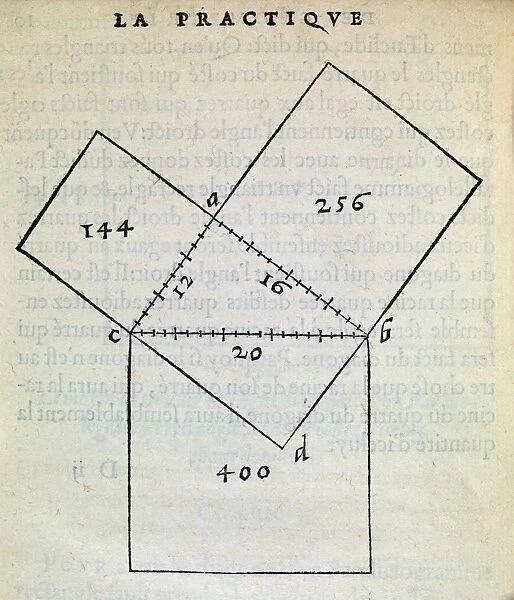Pythagorean theorem, 16th century C017 / 8002
![]()

Wall Art and Photo Gifts from Science Photo Library
Pythagorean theorem, 16th century C017 / 8002
Pythagorean theorem, 16th century. This theorem, named for 6th-century BC Ancient Greek mathematician Pythagoras, states that in a right-angled triangle, the sum of the square of the hypotenuse (the side opposite the right angle) is equal to the sum of the squares of the other two sides. This diagram shows the squares for a triangle with sides in the ratio 3:4:5 (here, the actual unit lengths are 12, 16 and the hypotenuse of 20). The squares 144 and 256 add up to the square of the hypotenuse: 400. A side-based right-angled triangle, this is the simplest example of a Pythagorean triple. From La practique de geometrie (1575) by Jean des Merliers
Science Photo Library features Science and Medical images including photos and illustrations
Media ID 9209999
© MIDDLE TEMPLE LIBRARY/SCIENCE PHOTO LIBRARY
1500s 1575 16th Century Book Diagram Formula French Geometrical Geometry Manuscript Mathematical Mathematics Mediaeval Medieval Middle Ages Page Primitive Publication Simplest Square Squares Theorem Triangle Triangular Pythagorean Theorem Ratio
EDITORS COMMENTS
This print showcases the Pythagorean theorem, a fundamental concept in mathematics that has stood the test of time. Dating back to the 16th century, this illustration originates from Jean des Merliers' book "La practique de geometrie" published in 1575. The theorem itself is named after Pythagoras, an ancient Greek mathematician who lived in the 6th century BC. The diagram beautifully demonstrates how the sum of the squares of two shorter sides in a right-angled triangle equals the square of its hypotenuse. In this particular example, with side lengths in a ratio of 3:4:5, we see squares measuring 144 and 256 which combine perfectly to form a square with an area equal to that of the hypotenuse's square - precisely 400 units. This artwork not only represents an important mathematical principle but also highlights its historical significance during medieval times. It serves as evidence that even centuries ago, scholars were exploring complex geometric concepts and documenting their findings for future generations. As we gaze upon this image today, we are reminded of both our intellectual heritage and humanity's timeless pursuit of knowledge. This visual representation allows us to appreciate how mathematics transcends time and culture while providing us with invaluable tools for understanding our world.
MADE IN AUSTRALIA
Safe Shipping with 30 Day Money Back Guarantee
FREE PERSONALISATION*
We are proud to offer a range of customisation features including Personalised Captions, Color Filters and Picture Zoom Tools
SECURE PAYMENTS
We happily accept a wide range of payment options so you can pay for the things you need in the way that is most convenient for you
* Options may vary by product and licensing agreement. Zoomed Pictures can be adjusted in the Cart.

